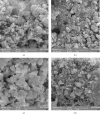Effect of Manipulation Methods and Storage Environments on the Microstructural, Chemical, and Mechanical Properties of Calcium-Enriched Mixture Cement
- PMID: 39877405
- PMCID: PMC11772065
- DOI: 10.1155/ijbm/5560351
Effect of Manipulation Methods and Storage Environments on the Microstructural, Chemical, and Mechanical Properties of Calcium-Enriched Mixture Cement
Abstract
This study aimed to evaluate the impact of different manipulation methods and storage environments on the microstructural, chemical, and mechanical properties of calcium-enriched mixture (CEM) cement. Four sample groups were examined, including nondried (ND-I) and dried (D-I) groups placed directly in an incubator, dried samples stored in phosphate-buffered saline (PBS) (D-P), and dried samples stored in distilled water (D-W). Various analyses, including Vickers microhardness, compressive strength, Fourier transform infrared spectroscopy (FTIR), X-ray diffraction (XRD), and scanning electron microscopy (SEM) with energy-dispersive X-ray spectroscopy (EDS) were conducted after incubating the samples for 7 days. The data were analyzed by Shapiro-Wilk, Levene, independent t, one-way ANOVA, and Tukey HSD tests. Key findings include the ND-I group exhibited a significantly longer setting time but the lowest microhardness and compressive strength. D-P showed the highest microhardness, while D-W displayed the highest compressive strength. FTIR analysis revealed vibration modes related to (PO4)3- ions and Si compounds in all groups, with dried groups showing more vibrations of (PO4)3- ions and OH groups, and D-P and D-W groups displayed vibration modes of (CO3)2- ions. XRD analysis indicated increased tri/dicalcium silicate reflections in CEM groups exposed to PBS or distilled water. D-I and D-W groups presented hexagonal or rectangular cubic and needle-like crystals, while D-P showed a homogeneous globular structure covered with fine crystals. The order of the weight percentage of major elemental constituents of D-P group was oxygen, calcium, phosphorus, zirconium, barium, carbon, silicon, and sulfur. Incremental placement, drying each increment, and exposing CEM to PBS/tissue fluids result in a faster set and more tolerant cement with a more uniform microstructure. The formation of hydroxyapatite can occur on the surface of the set cement.
Keywords: Fourier transform infrared spectroscopy; X-ray diffraction; biomaterials; calcium-enriched mixture cement; energy-dispersive X-ray spectroscopy; mechanical properties.
Copyright © 2025 Leyla Roghanizadeh et al. published by John Wiley & Sons Ltd.
Conflict of interest statement
The authors declare no conflicts of interest.
Figures




References
-
- Sanz J. L., Rodríguez-Lozano F. J., Lopez-Gines C., Monleon D., Llena C., Forner L. Dental Stem Cell Signaling Pathway Activation in Response to Hydraulic Calcium Silicate-Based Endodontic Cements: A Systematic Review of In Vitro Studies. Dental Materials . 2021;37(4):e256–e268. doi: 10.1016/j.dental.2021.01.025. - DOI - PubMed
LinkOut - more resources
Full Text Sources

